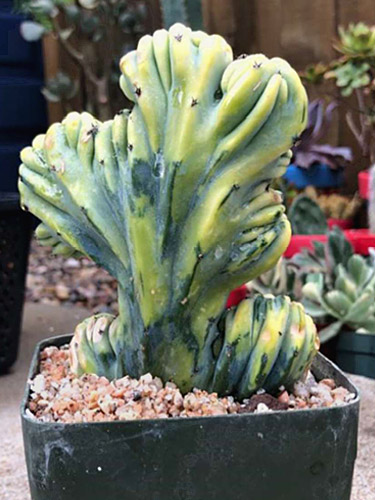– Myrtillocactus geometrizans f. cristatus variegatus (2023)

By Andrea M. Salazar (October 2023)
The stunning Myrtillocactus geometrizans f. cristatus variegatus certainly stole a few looks and gasps at the 2023 HSCSS picnic. I was the lucky brat who won it in the raffle. Though I do not deserve it, I’ll be forever grateful to the HSCSS community and its officers, especially to Don Lesmeister for such a warm welcome, as well as Mike Hellmann’s and Marge Williams’ magic hands.
This specimen, commonly known as the variegated crested blue candle cactus or variegated dinosaur back plant, is a striking and unique cultivar of the Myrtillocactus geometrizans species. This species lives in tropical deciduous forest and xerophilous scrublands, and less frequently in grassland in some areas of the Chihuahuan Desert. The plants are generally found in limestone soils, often with high salt content.
Native to northern central Mexico down to Oaxaca, this cactus mesmerizes with its crested form and, as a variegated cultivar, adds a splash of colorful charm to any cactus collection. In this article, we will explore what makes this cactus so special.
Surreal Beauty
This cultivar stands out due to the pleasant contrast between its pale-yellow coloring and its underlying glaucous-blue epidermis. In addition, it exhibits an architectural crest that will show clustering fanlike growth over time.
The famous standard Myrtillocactus geometrizans is a columnar, candelabra-shaped tree cactus that grows dense, pale-blue stems. In nature, it can reach 15 feet in height and 16 feet in width. Therefore, this variegated cultivar could likely reach these measurements under certain growth conditions.
As for the spines, each areole may have up to nine spines, but generally they have three to five spines about 10 millimeters long. The Myrtillocactus geometrizans, when well-established, offers small, white flowers to welcome the spring. If the flowers have been pollinated, they mature into rather sweet, dark-red fruit.
The Variegation
The topic of variegation is thoroughly explained in HSCSS member Eric Driskill’s article “Variegated Cacti,” found on the HSCSS website and in the February 2017 HSCSS Digest. Variegation in plants refers to the occurrence of atypical color patterns on leaves or stems, characterized by the absence of green chlorophyll pigment. This phenomenon results in areas of the plant displaying stripes, streaks, blotches or spots of colors other than green, such as white, yellow, pink or red.
If the tissues are filled with carotenoid pigments, then they typically adopt white or pale-yellow tones like Myrtillocactus geometrizans f. cristatus variegatus does. If the tissues are in the presence of betalain or anthocyanin pigments, they will display red hues.
For some of us, variegation catches the eye no matter what the color or the plant is. Variegation can occur temporarily due to a lack of nutrients, lack of light or an infection. Or it can be true variegation due to a genetic mutation, either natural or artificial. Some cactus cultivars are more prone to variegation than others, and factors like stress, injury or exposure to intense sunlight can trigger or enhance variegation in these succulents.
How to Care for It
As explained by Eric Driskill, caring for variegated plants does require special considerations. Variegated specimens come in two forms: those grown on their original roots and those grafted onto other plants. Both types demand special care, with particular attention required for those growing on their own roots.
When transitioning plants to receive more sunlight, gradual acclimatization is advisable, especially for variegated plants. It is important to note that most expert growers recommend eventually placing variegated plants on their original roots in strong light conditions, as they possess lower chlorophyll levels.
Regarding Myrtillocactus geometrizans f. cristatus variegatus, most growers consider it a challenge even for advanced growers (Big oops!) when the plants are not grafted. They recommend aggressive and prolonged exposure to direct sunlight, especially during the hottest summer days.
There is no doubt that Myrtillocactus geometrizans f. cristatus variegatus is one of nature’s finest. I hope in the future I get to share good news regarding the journey of this little fella. In the meantime, I will try to figure out where to put all these greens for the winter! Happy cactusing!
Sources:
Myrtillocactus geometrizans – Sánchez, E.; Guadalupe Martínez, J.; Hernández, H.M.; Gómez-Hinostrosa, C. and Cházaro, M. – 2013
IUCN Red List of Threatened Species, Version 2022-2 – https://www.iucnredlist.org
Las Cactáceas de Mexico, Volume I – Bravo Hollis, Helia; and Sánchez-Mejorada, Hernando – 1978
Llifle Encyclopedia of Cacti – http://www.llifle.com/Encyclopedia/CACTI/Family/Cactaceae/23043/Myrtillocactus_geometrizans_f._cristatus_variegatus
